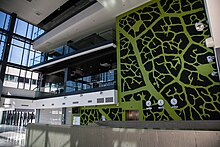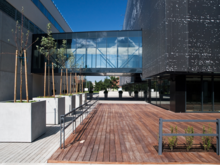| Revision as of 08:53, 1 October 2015 editKadri Talvistu (talk | contribs)17 editsNo edit summary← Previous edit | Revision as of 08:58, 1 October 2015 edit undoKadri Talvistu (talk | contribs)17 editsNo edit summaryNext edit → | ||
| Line 21: | Line 21: | ||
| }} | }} | ||
| Established in 1918, '''Tallinn University of Technology (TUT)''' ({{lang-et|Tallinna Tehnikaülikool}}, abbreviated ''TTÜ'') is the only ] university in Estonia. |
Established in 1918, '''Tallinn University of Technology (TUT)''' ({{lang-et|Tallinna Tehnikaülikool}}, abbreviated ''TTÜ'') is the only ] university in Estonia. TUT, in the capital city of ], is the nation’s leading academic institution in engineering, business, and public administration.<ref name=One>{{cite web|last=Study in Estonia|first=Study in Estonia|title=Tallinn University of Technology|url=http://www.studyinestonia.ee/study/institutions/international-degree-programmes/tallinn-university-of-technology|publisher=], Study in Estonia}}</ref><ref>{{cite web|last=Educations.com |first=Educations.com |title=Tallinn University of Technology|url=http://www.educations.com/Tallinn_University_of_Technology__b12666.html}}</ref> TUT has colleges in ], ], ] and ]. Despite the similar names, ] and Tallinn University of Technology are separate institutions. | ||
| ] | ] | ||
Revision as of 08:58, 1 October 2015
| Tallinna Tehnikaülikool | |
| File:Logo of Tallinn University of Technology.png | |
| Motto | Mente et manu |
|---|---|
| Motto in English | With wisdom and hands |
| Type | Public |
| Established | 1918 (1918) |
| Rector | Jaak Aaviksoo |
| Academic staff | 1,912 (and 268 international academic staff members) |
| Students | 14,151 (2011) |
| Location | Tallinn, Estonia 59°23′42″N 24°40′19″E / 59.3950°N 24.6719°E / 59.3950; 24.6719 |
| Affiliations | Campus Europae, CESAER |
| Website | www |
Established in 1918, Tallinn University of Technology (TUT) (Template:Lang-et, abbreviated TTÜ) is the only technical university in Estonia. TUT, in the capital city of Tallinn, is the nation’s leading academic institution in engineering, business, and public administration. TUT has colleges in Tallinn, Tartu, Kuressaare and Kohtla-Järve. Despite the similar names, Tallinn University and Tallinn University of Technology are separate institutions.



History
In the early twentieth century, Estonia recognised an urgent need for locally trained engineering specialists. Until then, young people from Estonia had received their specialist education in St. Petersburg, Germany or Riga. Opportunities had to be sought for engineering-minded people to acquire an Estonian-based education which was adapted to local conditions and needs; Estonia was in the process of establishing itself as an independent country.
On 17 September 1918, the Estonian Engineering Society opened an Estonian-based engineering school named Special Engineering Courses. That date has been recognised as the founding date of the Tallinn University of Technology. Programmes were offered in mechanical, electrical, civil and hydraulic engineering, shipbuilding and architecture. In 1919, the school became the private Tallinn College of Engineering, which in 1920 was declared a state institution. Teachers' efforts to develop an Estonian terminology for science and technology proved fruitful and the first engineering books were published. In 1923, the first engineering graduation theses were defended in Estonia. In the same year, a state laboratory of materials testing opened for research work.
By the 15 September 1936 Act of the Head of State, the school was granted university status, and named the Tallinn Technical Institute. The institute had two faculties: civil and mechanical engineering and chemistry and mining. In 1938, the name Tallinn Technical University (TTU) was effective. In 1940 the Faculty of Economics, in 1958 the Faculty of Power Engineering and in 1965 the Faculty of Control Engineering were founded. After 2003 the university was known in English as the Tallinn University of Technology (TUT).
On 1 July 2008, TUT took over International University Audentes (IUA), which became part of the Faculty of Economics and Business Administration, except the Law School which joined the Faculty of Social Sciences. In 2014 an agreement for merger of the Estonian Maritime Academy with TUT was signed.
TUT today
Tallinn University of Technology is a modern, international university teaching the newest knowledge and skills necessary for today’s international and competitive marketplace. With strong emphasis on internationalization, TUT has a strong multicultural student body (there are students from over 80 countries), many international professors (10% foreign staff members), great cooperation with the world's top universities (e.g., Berkeley, Stanford, Aalto, Shanghai Jiao Tong) and with international companies (e.g., Microsoft, ABB, IBM, etc.).
There are 21 fully accredited international degree programmes (17 Master programmes and 4 Bachelor programmes) that are available fully in English.
Tallinn University of Technology has an office in Silicon Valley, California which offers internship and training possibilities. The cooperation and exchange programmes with world´s top universities provides TUT students chance to study a semester or a year abroad.
A degree from TUT can be the basis for further academic work; graduates of TUT have been admitted to Oxford University, Harvard University, Brown University, University of California Berkeley, the University of London, University of Mannheim, Chalmers University of Technology, KTH, Aalto University, St. Gallen University, University of Southern Denmark and other renowned academic institutions.
Faculties
- Chemical and Materials Technology: Dean Malle Krunks (Leading Research Scientis)
- Civil Engineering: Dean Prof. Siim Idnurm
- Economics and Business Administration: Dean Prof. Üllas Ehrlich
- Social Sciences: Dean Prof. Sulev Mäeltsemees
- Mechanical Engineering: Dean Prof. Tauno Otto
- Information Technology: Dean Prof. Gert Jervan
- Power Engineering: Dean Prof. Arvi Hamburg
- Science: Dean Prof. Tõnis Kanger
Institutes
- Certification Centre: Director Tanel Tusik
- Institute of Cybernetics: Director Prof. Andrus Salupere
- Institute of Geology: Director Prof. Alvar Soesoo
- Institute of Marine Systems: Director Prof. Jüri Elken
- Technomedicum: Director Prof. Kalju Meigas
International degree programs in English
The internationalization of higher education is one of the key strategic goals of Tallinn University of Technology. The university offers 21 degree programmes in English: 17 Master programmes and 4 Bachelor programmes.
Bachelor level programmes:
- International Business Administration (Tallinn School of Economics and Business Administration)
- International Relations (Tallinn School of Economics and Business Administration)
- Law (Tallinn Law School in the Faculty of Social Sciences)
- Integrated Engineering
Master level programmes:
- European Architecture (Faculty of Civil Engineering)
- International Business Administration (MBA)(Tallinn School of Economics and Business Administration )at Tallinn University of Technology)
- International Relations and European-Asian Studies (Tallinn School of Economics and Business Administration )at Tallinn University of Technology)
- Law (Tallinn Law School at Tallinn University of Technology)
- Law and Technology (Tallinn Law School at Tallinn University of Technology)
- Technology Governance (Faculty of Social Sciences)
- Computer and Systems (Engineering Faculty of Information Technology)
- Communicative Electronics (Faculty of Information Technology)
- Industrial Engineering and Management (Faculty of Mechanical Engineering)
- Environmental Management and Cleaner Production (Faculty of Civil Engineering)
- Health Care Technology (The Institute of Clinical Medicine, Technomedicum)
- Work and Organizational Psychology (Faculty of Social Sciences)
- e-Governance Technologies and Services (Faculty of Information Technology)
- Technology of Wood and Plastic (Faculty of Chemical and Materials Technology)
- Mechatronics (Faculty of Mechanical Engineering)
Joint Master programmes coordinated by Tallinn University of Technology:
- Cyber Security (Faculty of Information Technology, joint programme with University of Tartu)
- Materials and Processes of Sustainable Energetics (Faculty of Chemical and Material Technology, joint programme with University of Tartu)
- Design and Engineering (Faculty of Civil Engineering, joint programme with Estonian Academy of Arts)
Joint Master programmes coordinated by other institutions:
- Software Engineering (joint programme with University of Tartu)
Alumni
Besides the entire technological elite of Estonia, alumni include numerous industrialists and businessmen, including Hardi Meybaum, the CEO and a co-founder of GrabCAD; the Chairman of the Estonian Chamber of Commerce, Toomas Luman; and the former Prime Minister and eminent industrialist Tiit Vähi. The Vice President and former President of the Estonian Academy of Science, Jüri Engelbrecht, is also a member of TUT.
Partner universities
The cooperation, especially with European universities is more focused for curricula development, project cooperation and networking. In Europe, student and staff mobility is mainly organised under Erasmus programme. A selection of university-wide partnerships:
 University of Applied Sciences Upper Austria
University of Applied Sciences Upper Austria Mount Saint Vincent University
Mount Saint Vincent University University of Science and Technology Beijing
University of Science and Technology Beijing University of Shanghai for Science and Technology
University of Shanghai for Science and Technology China University of Petroleum
China University of Petroleum Qingdao University of Science and Technology
Qingdao University of Science and Technology Universidad Organización y Método
Universidad Organización y Método Aalto University School of Science and Technology
Aalto University School of Science and Technology Caucasus University
Caucasus University Brandenburg University of Technology
Brandenburg University of Technology University of Electro-Communications
University of Electro-Communications Tokyo Denki University
Tokyo Denki University Sun Moon University of Korea
Sun Moon University of Korea Korea Polytechnic University
Korea Polytechnic University Kyungpook National University
Kyungpook National University Hallym University
Hallym University Šiauliai University
Šiauliai University CINVESTAV
CINVESTAV University of Oslo
University of Oslo Saint-Petersburg State University of Engineering and Economics
Saint-Petersburg State University of Engineering and Economics Saint Petersburg State University of Information Technologies, Mechanics and Optics
Saint Petersburg State University of Information Technologies, Mechanics and Optics Bauman Moscow State Technical University
Bauman Moscow State Technical University National University of Singapore
National University of Singapore FUNDESEM Business School
FUNDESEM Business School Universidad Politecnica de Valencia
Universidad Politecnica de Valencia Royal Institute of Technology
Royal Institute of Technology Southern Taiwan University of Technology
Southern Taiwan University of Technology National Taiwan University of Science and Technology
National Taiwan University of Science and Technology Istanbul Technical University
Istanbul Technical University National Technical University of Ukraine
National Technical University of Ukraine Stanford University
Stanford University University of New Mexico
University of New Mexico Southern Utah University
Southern Utah University
References
- ^ Study in Estonia, Study in Estonia. "Tallinn University of Technology". Archimedes Foundation, Study in Estonia.
- Educations.com, Educations.com. "Tallinn University of Technology".
- Tallinn University of Technology, Tallinn University of Technology. "International research university". Tallinn University of Technology. Retrieved 1 August 2012.
- ^ Tallinn University of Technology, Tallinn University of Technology. "Why TUT". Tallinn University of Technology.
- Tallinn University of Technology. "Tallinn Tech in the Heart of Silicon Valley". Tallinn University of Technology. Retrieved 2015-10-01.
- Tallinn University of Technology, Tallinn University of Technology. "Master's studies". Tallinn University of Technology. Retrieved 1 August 2012.
- Tallinn University of Technology, Tallinn University of Technology. "Bachelor's studies". Tallinn University of Technology. Retrieved 1 August 2012.
- Tallinn University of Technology, Tallinn University of Technology. "TUT's partner universities". Tallinn University of Technology. Retrieved 1 September 2015.
External links
- Tallinn University of Technology
- 6-min. video clip featuring TUT
- http://www.ttu.ee/studying/masters/masters_programmes/egovernance/